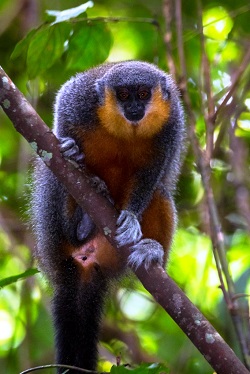Zoologists shed new light on origins of titi monkey
Scientists in Salford have shed new light on the evolution of one of the world’s most diverse primate groups – the titi monkey.
Dr Jean Boubli and PhD student Hazel Byrne, working with zoologists from Brazil and the US, used cutting-edge molecular and supercomputer modeling techniques to investigate the genus Callicebus, first described by Thomas in 1903. 
Published in the journal Frontiers in Zoology, the research identifies much greater diversity in the titi which they propose to redefine as three distinct genera – Callicebus (Titi), Chaeracebus and Plecturocebus.
They have also reclassified the species dubius as caligatus, reducing the number of recognised species from 34 to 33.
“By dividing the titi monkeys into three new genera we are better describing biodiversity by acknowledging the evolutionary uniqueness of these old lineages,” explains Dr Boubli, reader in animal ecology at the University of Salford, who described the findings as the “culmination of his 20 year quest for the origins of titi monkey diversity.”
Decades of samples
Jean, who spent three years with the Yanomami peoples in the northern Amazon, and Hazel who also spent months in the jungle, built the largest array of titi monkey DNA sequences ever assembled, affording a fresh perspective on the key evolutionary events and when they occurred over time.
The team ran hundreds of genetic codes through computer programmes which simulated their evolution over a millions of generations.
They pinpoint the split between Plecturocebus and Callicebus at approximately 11 million years ago and the split of Callicebus and Cheracebus to 8 million years.
"Historically taxonomy (the classification of animals) has been largely based on morphology - colour, shape, size, features – rather than genetic diversity. However, things can be very closely related and look quite different, or be genetically distinct and look the same."
So does it matter?"
“Absolutely”, says Dr Boubli who describes taxonomy as “the road map of conservation” and ultimately, our understanding of how the evolutionary tree of primates fits together, guides decisions about which groups are endangered and which need protection.
“Each of the three genera can now be recognised as unique, important lineages, giving governments and NGOs a clearer focus for conservation programmes.
“It makes sense that before you say ‘we’re going to dedicate our resources to this, you need to know what ‘this’ is."
The team are following up the research with a forthcoming biogeographical analysis, investigating how these genera diversified over time and space, which could shed light on how the Amazon was formed.
